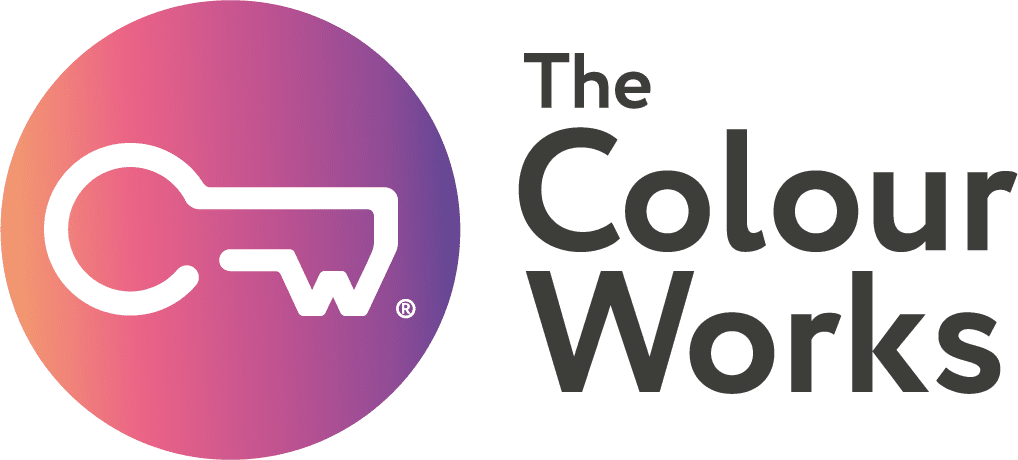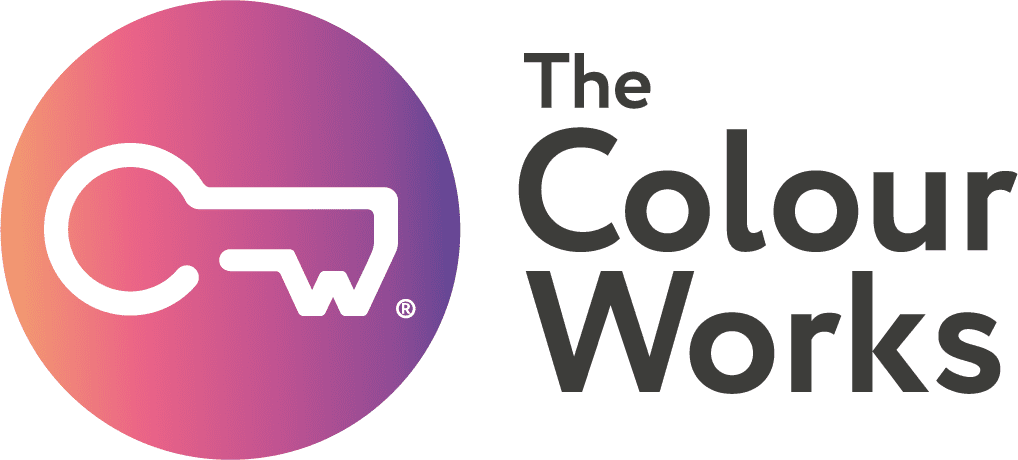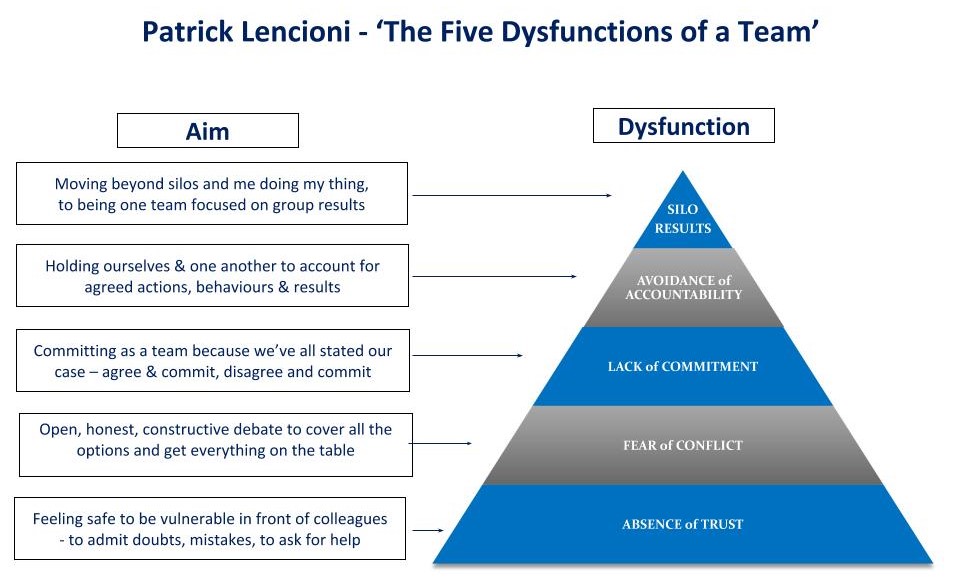If we don’t feel safe to be vulnerable in front of one another, he argues, then that lack of trust fundamentally undermines our ability to have open, honest and robust discussions. We hold back, keep our heads below the parapet and let others do the talking. Instead of engaging in healthy, respectful conflict, we get stunted, lifeless meetings where people fall into line but never really agree and commit.
Imagine 10 people discussing how they’re going to meet the coming year’s challenging stretch targets. Maybe two or three don’t feel safe to say what’s on their minds. That means as much as 20 or 30% of potentially vital input is being withheld in some shape or form. Ramp that figure up to four, five or six people feeling unsafe and the team has a serious problem. Perhaps they won’t all stay silent but what they say will likely be a long way off what they really think and feel, and that almost inevitably will lead to low levels of commitment, accountability and results delivery.
How to have a healthy conflict
Well-managed and healthy conflict is essential to the healthy functioning of any team and people need to feel safe and skilled enough to engage in it as simply just one more aspect of how we do things – no big drama. So, what can we do to promote healthy conflict? What steps can we take?
Creating the right environment for healthy conflict
- Build trust
Step one is very much about building levels of trust within the team – but it doesn’t end there, of course. (see our November blog on building psychological safety for more on this)
2. Leverage that trust
Step two of Lencioni’s model urges us to leverage that trust and at the same time strengthen it by raising our game when it comes to discussing difficult and often stressy issues. What we’re looking for here is to get everything that matters out there on the table so it can be looked at, talked about, scrutinised, weighed up, thrashed out and done with. All ideas are welcome, all voices are heard, all viewpoints are valued. Google, for example, make a point of not ending a meeting until everyone has made a significant contribution.
3. Everyone has something of value to offer
This sits right at the core of the Insights colour model – the most successful teams are those that extract the greatest value from those who make up the team. Every team has its stars, higher flyers and alpha males and females, but no team can afford to allow some people to dominate at the expense of others.
4. Exercise good emotional intelligence
Opinion leaders and stronger characters need to know when to exercise restraint and make sure quieter team members don’t feel pushed to the margins of the meeting. By the same measure, quieter, more introverted members of the team need to step up a gear and make a solid contribution, even though they may want more time to analyse and reflect.
This is as much about chairing meetings well as it is about people exercising good emotional intelligence. If conversations get heated and passionate, some team members will feel uncomfortable – it’s perfectly natural. But we can all be acclimatised to these experiences if we’re regularly exposed to well-managed, challenging and respectful discussions.
5. Lead by example
Leaders – to paraphrase Mahatma Gandhi – be the behaviours you want to see.
6. No pulling rank
Dispense with overt hierarchies during key discussions. This doesn’t mean team leaders relinquish control or the right and responsibility for making a final decision. But if teams are to feel safe in engaging in robust discussion, then everyone’s views have to have equal value, at least until it comes to decision time. No-one has a monopoly on knowing the right answer and leaders shouldn’t shoulder that burden!
7. Chatham House Rule (there’s only one!)
What’s said in the room stays in the room … kind of! What the Chatham House Rule means is that participants should not spread word of who said what after a sensitive or fractious meeting is finished. By all means share what was said but not by whom!
8. Keep it positive
Focus on solutions more than problems, opportunities more than threats. By all means be real, but wherever possible, keep the conversation positive. What do we want instead of the current problem/situation? How might it be solved? Who or what will help us get there?
9. No finger pointing
Forget blame, focus on learning from mistakes and finding solutions.
10. Insist on 100% transparency & leave no stone unturned
When three astronauts died in a capsule fire during an Apollo 1 pre-launch test in 1967, NASA undertook a root and branch overhaul of its entire space programme. Everyone knew corners were being cut in the race to land a man on the moon, but few spoke up and even fewer were prepared to listen. When George Low was put in charge, everything changed. As he himself put it; “No detail was too small to consider. If we made a mistake, it was not because of any lack of candour between NASA and the contractor or between engineer and astronaut. Every question was answered, every failure understood, every problem solved.”
What’s the chances that all happened without the occasional cross word? Zero. But many, many problems were resolved and the team that reached for the Moon achieved their goal.
11. Agree and commit or disagree and commit but either way, get on board with the final decision
Make your case with all the passion and conviction you can muster but ultimately, when all is said and done, accept the final decision. Unanimous decisions will not often arise, and this must not unduly delay or prevent a decision being made. Keep all eyes and hearts firmly on the team prize!
12. Make it ok to challenge the status quo
Challenge ‘accepted’ and ‘obvious’ views – as entrepreneur Margaret Heffernan wisely said, “What would we see if we were wrong about this?”
13. Call out unhelpful behaviour
Calling out unhelpful behaviour isn’t about punishing or embarrassing people for getting something wrong or stepping out of line, but anything that undermines the psychological safety and health of the team needs to be dealt with. No need to make a big song and dance about it – discuss it, understand it, learn from it and move on.
14. Drain the swamp
This can be a tough one, but it really does need to be faced up to eventually … do your utmost to lay to rest any old, thorny, toxic issues or disagreements that just keep on polluting the water. While they sit and fester, your team at best will never really function the way it could and at worst will suffer a perpetual hangover.
15. Maintain positive regard for one another
Last and most definitely not least, each member of the team needs to maintain a positive sense of regard for their colleagues, especially when the stakes are high and discussions get heated. For sure, be authentic to the situation and how you feel about it, but for conflict to remain healthy, we need to know others respect us, care about us and want things to turn out well for everyone concerned. The success of the team depends on it.
“Love is the only force capable of turning an enemy into a friend.” Dr Martin Luther King Jr








